lecture4(静态测试)
2 静态测试

2. 程序阅读
• 审查组人员仔细阅读代码和相关材料 • 对照代码审查单标出明显缺陷及错误
3. 审查会
• 审查会由组长主持 • 首先由程序员逐句阐明程序的逻辑,在此过程中可由 程序员或其他小组成员提出问题,追踪错误是否存在 • 经验证明在上述阐述过程中,有很多错误由讲述程序 者而不是其他小组成员发现 • 大声地朗读程序给听众,这样简单的工作是有效的错 误检测技术 • 然后利用代码审查单来分析讨论 • 组长负责讨论沿着建设性的方向前进,而其他人则集 中注意力发现错误,但不去纠正错误
G.J.Myers的代码审查单(部分)
• 数据引用错误
– 是否引用了未赋值或者未初始化的变量? – 所有的数组引用,其下标值是否都在各自的相 应维数定义界内? – 所有的数组引用,每一个下标是否是整数值? – 所有引用的指针或变量当前是否已经分配储存 了?(即是否存在“悬挂引用”的问题) – 在检索操作或用下标引用数组时,是否存在“ 差1”的错误?
代码走查会的内容
• 与代码审查不同,不是读程序和使用代码审查单 • 而是由被指定的作为测试员的小组成员提供若干测 试用例(程序的输入数据和期望的输出结果),让 参加会的成员当计算机,在会议上对每个测试用例 用头脑来执行程序,也就是用测试用例沿程序逻辑 走一遍,并由测试人员讲述程序执行过程,在纸上 或黑板上监视程序状态(变量的值) • 每次开会时间以1-2小时为宜,但不允许中断 • 如果发现问题由秘书记下来,中间不讨论任何纠错 问题,主要是发现错误
内容
• 静态测试技术
– 代码审查 – 代码走查
• 静态测试的内容
– 需求定义的静态测试 – 设计文档的静态测试 – 源代码的静态测试
代码走查
• 代码走查与代码审查相似,它也是由一组 程序和错误检查技术组成,只是程序和错 误检查技术不完全相同
静态动词专四真题答案解析
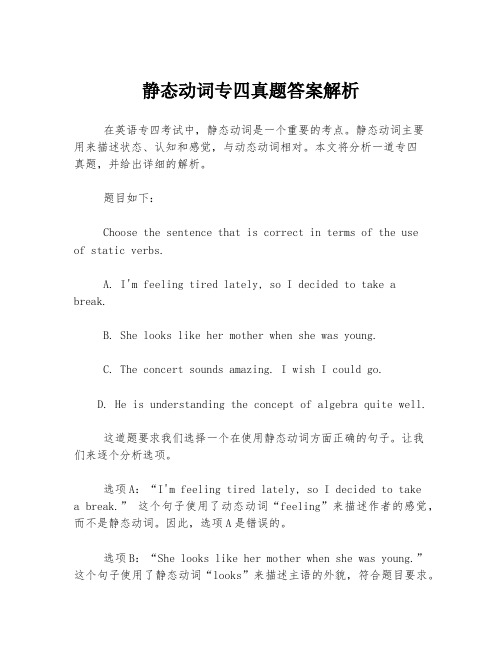
静态动词专四真题答案解析在英语专四考试中,静态动词是一个重要的考点。
静态动词主要用来描述状态、认知和感觉,与动态动词相对。
本文将分析一道专四真题,并给出详细的解析。
题目如下:Choose the sentence that is correct in terms of the useof static verbs.A. I'm feeling tired lately, so I decided to take a break.B. She looks like her mother when she was young.C. The concert sounds amazing. I wish I could go.D. He is understanding the concept of algebra quite well.这道题要求我们选择一个在使用静态动词方面正确的句子。
让我们来逐个分析选项。
选项A:“I'm feeling tired lately, so I decided to takea break.” 这个句子使用了动态动词“feeling”来描述作者的感觉,而不是静态动词。
因此,选项A是错误的。
选项B:“She looks like her mother when she was young.” 这个句子使用了静态动词“looks”来描述主语的外貌,符合题目要求。
因此,选项B是正确的。
选项C:“The concert sounds amazing. I wish I could go.” 这个句子使用了静态动词“sounds”来描述音乐会的听觉感受,符合题目要求。
因此,选项C是正确的。
选项D:“He is un derstanding the concept of algebraquite well.” 这个句子使用了动态动词“is understanding”来描述主语正在进行的行为,而不是静态动词。
静态测试实验报告
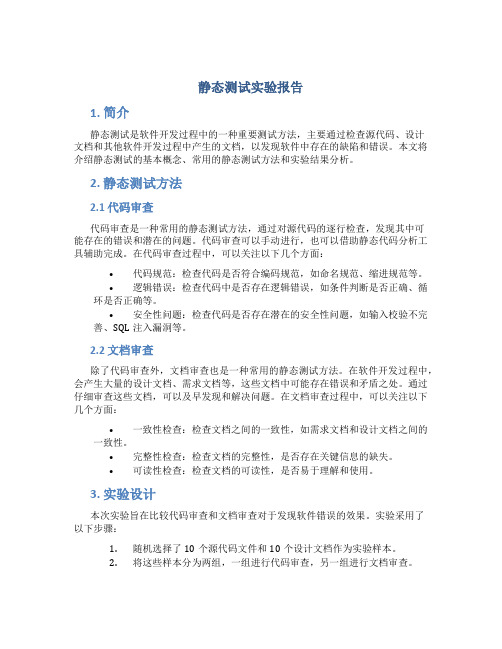
静态测试实验报告1. 简介静态测试是软件开发过程中的一种重要测试方法,主要通过检查源代码、设计文档和其他软件开发过程中产生的文档,以发现软件中存在的缺陷和错误。
本文将介绍静态测试的基本概念、常用的静态测试方法和实验结果分析。
2. 静态测试方法2.1 代码审查代码审查是一种常用的静态测试方法,通过对源代码的逐行检查,发现其中可能存在的错误和潜在的问题。
代码审查可以手动进行,也可以借助静态代码分析工具辅助完成。
在代码审查过程中,可以关注以下几个方面:•代码规范:检查代码是否符合编码规范,如命名规范、缩进规范等。
•逻辑错误:检查代码中是否存在逻辑错误,如条件判断是否正确、循环是否正确等。
•安全性问题:检查代码是否存在潜在的安全性问题,如输入校验不完善、SQL注入漏洞等。
2.2 文档审查除了代码审查外,文档审查也是一种常用的静态测试方法。
在软件开发过程中,会产生大量的设计文档、需求文档等,这些文档中可能存在错误和矛盾之处。
通过仔细审查这些文档,可以及早发现和解决问题。
在文档审查过程中,可以关注以下几个方面:•一致性检查:检查文档之间的一致性,如需求文档和设计文档之间的一致性。
•完整性检查:检查文档的完整性,是否存在关键信息的缺失。
•可读性检查:检查文档的可读性,是否易于理解和使用。
3. 实验设计本次实验旨在比较代码审查和文档审查对于发现软件错误的效果。
实验采用了以下步骤:1.随机选择了10个源代码文件和10个设计文档作为实验样本。
2.将这些样本分为两组,一组进行代码审查,另一组进行文档审查。
3.在代码审查组中,由一名经验丰富的开发人员对源代码进行逐行审查,记录发现的错误和问题。
4.在文档审查组中,由一名经验丰富的软件测试人员对设计文档进行仔细审查,记录发现的错误和问题。
5.对实验结果进行统计分析,比较代码审查和文档审查的效果。
4. 实验结果分析经过实验,我们得到了以下结果:•代码审查组共发现了20个错误和问题,平均每个样本发现2个问题。
论静态测试方法及应用

论静态测试方法及应用Static testing is a software testing technique where the code of an application is reviewed without actually executing it. This approach involves a thorough examination of the code, requirements, and design documentation to identify errors and defects early in the development process. 静态测试是一种软件测试技术,它在不实际执行代码的情况下对应用程序的代码进行审查。
这种方法涉及对代码、需求和设计文档进行彻底检查,以便在开发过程早期识别错误和缺陷。
One of the key advantages of static testing is its ability to detect defects at an early stage, which can significantly reduce the cost of fixing them later in the development process. By identifying issues before the code is executed, static testing helps improve the overall quality of the software and increases the efficiency of the development team. 静态测试的关键优势之一是它能够在早期阶段检测出缺陷,这可以显著减少后续修复它们的成本。
通过在代码执行之前识别问题,静态测试有助于提高软件的整体质量,增加开发团队的效率。
3软件静态测试技术解析

第三章 软件静态测试技术
A Free sample background from
Slide 9
3.3 程序控制流分析方法
控制流图 控制流图(可简称流图)是对程序流程图进行简化后得到 的,它可以更加突出程序控制流的结构。 控制流图中包括两种图形符号:节点和控制流线。
(1)将程序流程图中的每个分支转换为一个独立的节点。 (2)在分支前的顺序块(不论有几个)均可合并入节点。 (3)对所有的节点及程序控制的流向进行编号。
对于复合条件,则可将其分解为多个单个条件,并映射成 控制流图。
第三章 软件静态测试技术
A Free sample background from
Slide 1
第3章 软件静态测试技术
3.1 软件静态测试 3.2 程序数据流分析方法 3.3 程序控制流分析方法 3.4 软件的复杂性度量 3.5 软件评审
第三章 软件静态测试技术
A Free sample background from
其中,E是控制流图中边的数量,N是控制流图中的节点 数量。
V(G) = P+1
其中,P是控制流图G中判定节点的数量。
环形复杂度的数值越大,理解程序模块的难度越高。通常 认为环形复杂度大于10是不可接受的,需要对程序进行 重新设计。
第三章 软件静态测试技术
A Free sample background from
(1)节点由带标号的圆圈表示,可代表一个或多个语句、 一个处理框序列和一个条件判定框(不包含复合条件)。 (2)控制流线由带箭头的弧线或直线表示,可称为边。它 代表程序中的控制流。
常见结构的控制流图
第三章 软件静态测试技术
Lecture_4
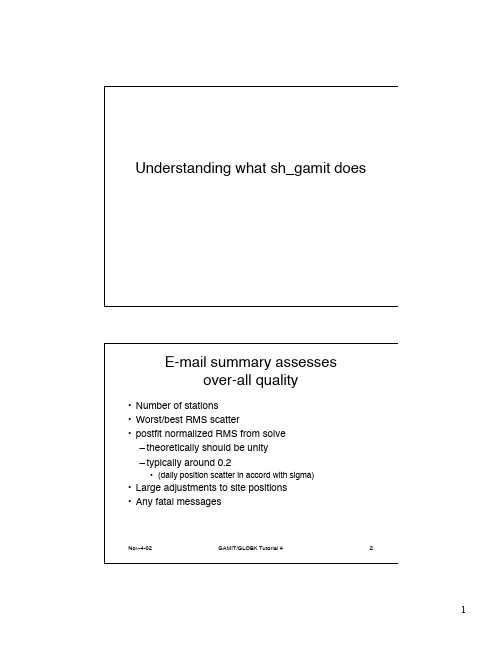
autcln summary file
• One-way post-fit residual statistics – Only in postfit autcln summary – Gives RMS in mm
• by station and each satellite for a station • Normal values are 3-10 mm • >10 mm is not good
Nov-4-02 GAMIT/GLOBK Tutorial 4 5
Analyzing a solution: bias parameters
• Number of biases fixed – Fixed bias have no sigmas in Q-file – 608 B1L1 SMYC-TBLE 4- 2 0.0000000000 10.0000 \ – 609*B1L1 SMYC-TBLE 4- 5 0.0000000000 2.3133 \ 0.0367 -2.31330402 – The * means not fixed and sigma is given • Adjustments – parameters should not change much
Nov-4-02 GAMIT/GLOBK Tutorial 4 7
autcln output
• autcln.out.Z – full output – automatically compressed – use uncompress or use zcat to view – Lists actions taken by autcln • autcln.prefit.sum • autcln.post.sum – Summaries – Look at these
804(3)-5静态测试指南
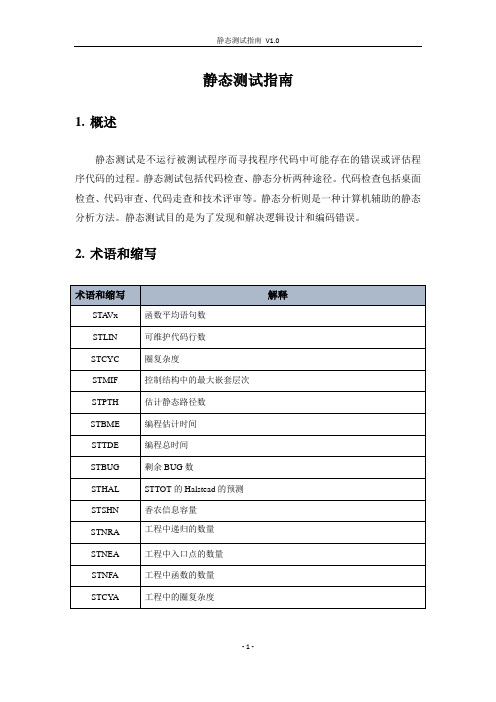
静态测试指南1.概述静态测试是不运行被测试程序而寻找程序代码中可能存在的错误或评估程序代码的过程。
静态测试包括代码检查、静态分析两种途径。
代码检查包括桌面检查、代码审查、代码走查和技术评审等。
静态分析则是一种计算机辅助的静态分析方法。
静态测试目的是为了发现和解决逻辑设计和编码错误。
2.术语和缩写3.参考文档《QAC-8.1-Win-UsersGuide.pdf》《1.1-使用基本配置.pdf》《1.2-编码规则检查.pdf》《1.3-代码结构和度量.pdf》《2.2-规则裁剪与定制.pdf》《2.3-度量指标解析.pdf》4.度量指标的解析4.1函数度量的关键指标1)STA Vx-函数平均语句数该度量用于检测长语句的部分。
由大量文本元素(操作符和操作数)构成的语句需要阅读者花费大量的精力。
因此,该度量可以看成是程序可读性的标志。
2)STLIN -可维护代码行数该度量值与代码可读性相关,越长的函数越难读,为便于单屏或单页阅读,建议该度量值上限为200。
3)STCYC -圈复杂度圈复杂度高时意味着函数的模块化不充分或者函数内逻辑过于复杂。
软件度量研究标明,圈复杂度大于10的函数都可能存在复杂度的问题。
4)STMIF -控制结构中的最大嵌套层次该度量表示代码中控制流图中最大的嵌套深度。
推荐最大值为5。
降低该值的办法之一是将嵌套拆分成多个函数,这样可以改进代码可读性,降低嵌套数和函数圈复杂度。
5)STPTH -估计静态路径数该度量类似于Nejmeh的NPATH统计,给出了函数控制流图中可能路径的上限。
它是函数中非循环执行路径的数目。
4.2文件度量的关键指标1)STBME - 编程估计时间估计每个源文件开发所需的时间,单位(人月)。
2)STTDE -编程总时间显示源码的开发所需总月数,单位(月)3)STBUG -剩余BUG数在记号估计的基础上,对文件中bug数量的估计。
它的值一般低于各函数STPBG的总和。
Lecture4Testspecifications
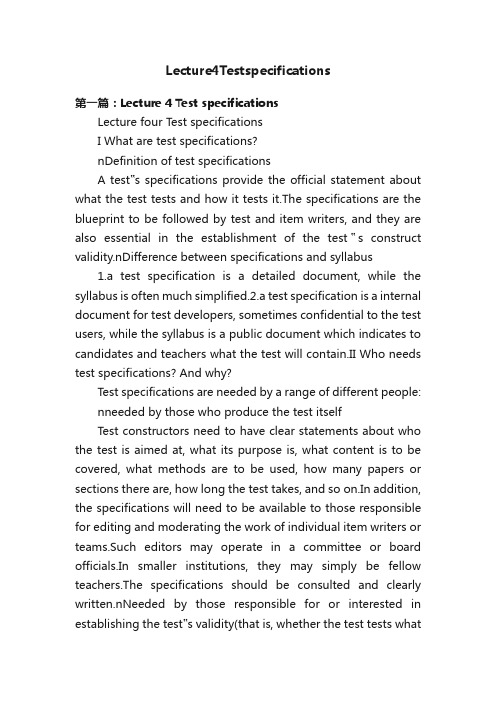
Lecture4Testspecifications第一篇:Lecture 4 Test specificationsLecture four Test specificationsI What are test specifications?nDefinition of test specificationsA test‟s specifications provide the official statement about what the test tests and how it tests it.The specifications are the blueprint to be followed by test and item writers, and they are also essential in the establishment of the test‟s construct validity.nDifference between specifications and syllabus1.a test specification is a detailed document, while the syllabus is often much simplified.2.a test specification is a internal document for test developers, sometimes confidential to the test users, while the syllabus is a public document which indicates to candidates and teachers what the test will contain.II Who needs test specifications? And why?Test specifications are needed by a range of different people: nneeded by those who produce the test itselfTest constructors need to have clear statements about who the test is aimed at, what its purpose is, what content is to be covered, what methods are to be used, how many papers or sections there are, how long the test takes, and so on.In addition, the specifications will need to be available to those responsible for editing and moderating the work of individual item writers or teams.Such editors may operate in a committee or board officials.In smaller institutions, they may simply be fellow teachers.The specifications should be consulted and clearly written.nNeeded by those responsible for or interested in establishing the test‟s validity(that is, whether the test tests whatit is supposed to test).Validators may think it is less important to have …practical information about the length of the test and its sections, and more important to know the theoretical justification for the content: what theories of language and proficiency make the test, and why the test is the way it is.nNeeded by test usersTest users need descriptions of a test‟s content, and different sorts of users may need somewhat different descriptions.For example, teachers who will be responsible for the learners placed in their classes by a test need to know what the test scores mean: what the particular learners knew, what they can do, what they need to learn.Teachers who wish to enter their students for some public examination need to know which test will be most appropriate for their learner in relation to the course that they have been following.nNeeded by publishersFinally, test specifications are a valuable source of information for publishers wishing to produce textbooks related to the test: textbook writers will ensure that the practice in books they produce are of an appropriate level of difficulty, with appropriate content, topics, tasks and so on.All these users of test specifications may have differing needs, and writers of specifications need to bear the audience in mind when producing their specifications.What is suitable for an audience may be quite unsuitable for another.III Contents of test specifications1.Test purpose2.Theoretical construct and operations3.Test takers4.Test content5.Test method6.Test tasks and text types7.Test organizations and weighting8.Time duration9.Scoring criterion10.Test administration11.Test development chartIV How to draw up test specifications?nTest purpose: tests tend to fall into one of the following broad categories: placement, progress, achievement, proficiency and diagnostic.Placement tests are designed to assess students‟level of language ability so that they can be placed in the appropriate course or class.Progress tests are given at various stages throughout a language course to see what the students have learnt.Achievement tests tend to be given at the end of the course.The content of both progress and achievement tests is generally based on the course syllabus or the course textbook.Proficiency tests are designed to test the ability of students with different language training backgrounds.Some are intended to show whether students have reached a given level of general language ability;others are designed to show whether students have sufficient ability to be able to use a language in some specific area such as medicine, tourism etc.Diagnostic tests seek to identify strengths and weaknesses in students‟ language ability.Test purpose is the normal starting point for designing test specifications.For example:Test A is a placement test, designed to place students applying for language courses at English into classes appropriate to their language level.Test B is intended to diagnose strengths and weaknesses of fourth year secondary school pupils in English grammar.nTest construct and operationsEvery test has a theory behind it: what language abilityconsists of, what language learning involves and what language users do with language.Every theory contains constructs, which are its principal components and the relationship between these components.Test specifications need to make the theoretical framework which underlies the test language skills and relationships between its constructs, as well as the relationship between the theory and what the test is designed for.The test domain is intended not to include all the skills of the construct but the representative contentsof the listing skillsFor example:Heaton(2000: 105-106), in his book “ Writing English Language Tests”, hypothesizes reading skills as the ability to: --recognize words and word groups, associating sounds with their corresponding graphic symbols;--deduce the meaning of words;--understand explicitly stated information;--understand relations within the sentence;--understand relations between parts of a text;--perceive temporal and spatial relationships and also sequences of ideas;--understand conceptual meaning;--anticipate and predict what will come next in the text;--identify the main idea and other salient features in a text;--generalize and draw conclusion;--understand information not explicitly stated by making references;--skim and scan(looking for the general meaning and reading for specific information);--read critically;--adopt a flexible approach and vary reading strategies according to the type of material being read and the purpose for which it is being read.nTest takersWhat sort of learner will be taking the test.Personal characteristics: age, sex, first language, country of origin, level and nature of education, reason for taking the test, professional interestsTopical knowledge: levels of target language social and cultural nguage ability: levels of target language knowledge and language use ability nTest content Topic is concerned with what the test is ready to measure, grammar or structure knowledge or writing, speaking and reading abilities.Focus is involved in what functions test tasks should enable students to use according to the above topic.Descriptions of test content should be detailed and comprehensive: test content should demonstrate that it tests what the test is supposed to test or test content validity;test content should be representative for test construct(construct validity).nTest methodWhat test methods are to be used –multiple choice, gap filling, matching, transformation, short answer question, picture description, role play with cue cards, essay, structured writing, etc?In taking test types, test writers should think about four aspects: test validity, reliability, authenticity and practicality.nTest tasks and text typesWhat sort of tasks are required – discrete point, integrative, authentic, objectively or subjectively assessable? If it is authentic, what text types should be chosen – writtenand/or spoken? What should be the sources of these, the topics, the degree of authenticity? How difficult or long shouldthey be? What functions should be embodied in the texts –persuasion, definition, summarizing, etc? How complex should the language be?nTest organizations and weightingTest organizations refer to number of items or tasks – how many items are required for each section? Weighting concerns what is the relative weight for each item – equal weighting, extra weighting for more difficult items.For example:weighting for written CET4新题型的四级考试主要由听力理解、阅读理解、完型填空或改错、写作和翻译四部分组成。
单元测试之静态测试

单元测试阶段的静态测试流程
1.编译器检查 2.利用工具进行静态分析 3.人工代码审查和代码走查
编译器和解释器是第一步的测试
静态分析
一、规则检查 1.代码符合行业规范,国家标准,企业内部规范 2.把艺术变成科学 3.去掉隐含的编码缺陷 4.前事不忘后事之师 常用工具:CodeWizard、C++ Test 、 Logiscope、 Cpptest、 PRQA
软件静态测试技术
什么是静态测试?
静态测试,是在不执行代码的情况下对代 码进行测试的过程。 适用对象: 计算机软件单元、计算机软件部件、 计算机软件配置项的源代码。 进入条件: 代码无错误地通过编译。
静态测试的方法
代码审查 代码走查 静态分析 1.控制流分析:使用控制流程图系统检查被测程序 的控制结构的工作。 2.数据流分析:使用控制流程图分析数据发生的异 常情况。 3.接口分析:程序静态分析和设计分析。 4.表达式分析:检查表达式的错误。
代码审查、走查
代码审查的内容:
检查代码和设计的一致性:即检查代码执行标准的情 况;检查代码逻辑表达的正确性;检查代码结构的合理性; 检查代码的可读性
代码审查的组织
由四人以上组成:组长,资深程序员,程序编写者 (秘书)和专职测试人员。组长不能是被测试程序的编写 者,组长负责分配资料,安排计划,主持开会,记录并保 存被发现的错误。
代码审查单
请参见GJB141-2004附录A,也可以根据具体项目情况 自行编写
代码审查、走查
注意事项
时间和地点应该避免被干扰 每次不应该超过6个小时,每小时审查150-200行代 码 树立正确的态度 实际项目的实施策略:上午组织会议审查,讲解 代码,不超过3个小时。下午测试人员和审查组长 总结上午的审查结果,填写问题报告单,如果可 以,请代码编写人员确认。具体审查的代码行数 可以根据实际情况增加或减少。
Testbed静态测试使用指南V1.1
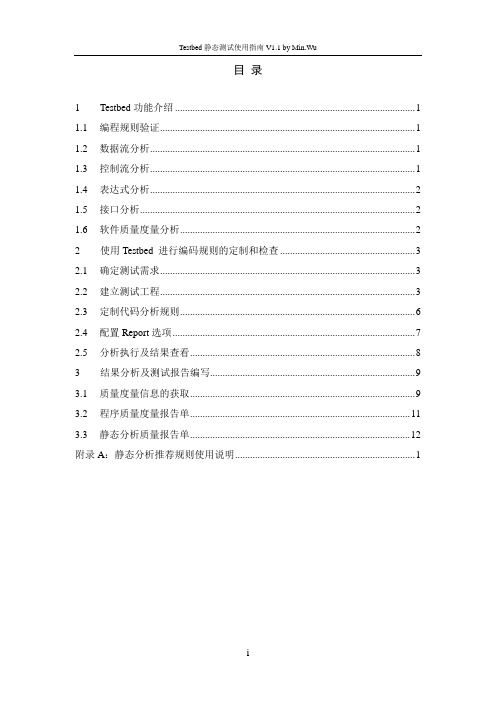
目录1Testbed功能介绍 (1)1.1编程规则验证 (1)1.2数据流分析 (1)1.3控制流分析 (1)1.4表达式分析 (2)1.5接口分析 (2)1.6软件质量度量分析 (2)2使用Testbed 进行编码规则的定制和检查 (3)2.1确定测试需求 (3)2.2建立测试工程 (3)2.3定制代码分析规则 (6)2.4配置Report选项 (7)2.5分析执行及结果查看 (8)3结果分析及测试报告编写 (9)3.1质量度量信息的获取 (9)3.2程序质量度量报告单 (11)3.3静态分析质量报告单 (12)附录A:静态分析推荐规则使用说明 (1)1Testbed功能介绍1.1编程规则验证编程标准验证是高可靠性软件开发不可缺少的软件质量保证方法,使用LDRA Testbed 自动地验证应用软件是否遵循了所选择的编程规则。
编程规则由软件项目管理者根据自身项目的特点并参考现有的成熟的软件编程标准制定,如DERA(欧洲防务标准),MISRA(汽车软件标准),LDRA Testbed依据此规则搜索应用程序,并判断代码是否违反所制定的编程规则。
LDRA Testbed报告所有违反编程规则的代码并以文本方式或图形反标注的方式显示。
测试人员或编程人员可根据显示的信息对违反编程规则的代码进行修改。
1.2数据流分析LDRA Testbed分析软件中全局变量、局域变量及过程参数的使用状况,并以图形显示、HTML或ASCII文本报告方式表示,清晰地识别出变量使用引起的软件错误,此种方法既可使用于单元级,亦可使用于集成级、系统级。
通过Testbed数据流分析功能,可方便地分析出软件中一些可能的程序欠缺,如:1.没使用的函数参数;2.不匹配的参数;3.变量未赋初值就引用;4.代码中有多余变量;5.给值传递参数赋值;6.无返回值的函数路径;7.函数的实参是全局变量。
1.3控制流分析控制流分析检查以下内容:1.不可达代码;2.不合理的循环结构;3.存在浮点相等比较;4.函数存在多个出口;5.函数存在多个入口。
2019-2020年电大考试《英语4》测验题及答案

一、选择填空题(每题10分,共5题)1—I'll also throw in the discount of 10% on your up front deposit. What do you think about this suggestion?—______________.正确答案是:Ok, I think we've both have done our best for this2—Could you be so kind as to turn down that rock “n”roll? I'm preparing for tomorrow's meeting report.—______________.正确答案是:Sure. Sorry to disturb you3Although he has sought to find a peaceful _____, he is facing more pressure from his business rivals.正确答案是:solution4______ has good reputation will sooner or later be successful in his business.正确答案是:Whoever5That might be acceptable ______ you handle the insurance fees.正确答案是:if 二、阅读理解/翻译/完形填空(题型随机)(共50分)6阅读理解:根据文章内容,选择正确答案(每题10分)。
Emotions play an important part in the negotiation process, although it is only in recent years that their effect is being studied. Emotions have the potential to play either a positive or negative role in negotiation. During negotiations, the decisionas to whether or not to settle rests in part on emotional factors. Negative emotions can cause intense and even irrational behavior, and can cause conflicts and negotiations to break down, but may be instrumental in attaining concessions. On the other hand, positive emotions often facilitate reaching an agreement and help to maximize joint gains, but can also be instrumental in attaining concessions. Positive and negative discrete emotions can be strategically displayed to influence task and relational outcomes and may play out differently across cultural boundaries.1. Emotions play an important role during the negotiation, although their effect is being studied just 回答B正确答案是:C.A. at the beginning of negotiation practiceB. during the negotiation processC. not long before2. Negative emotions may 回答A正确答案是:A make concessions.A. be helpful toB. be harmful toC. be nothing to3. During negotiations, the decision as to whether or not to settle depends in part on emotional factors.回答B正确答案是:BA. totallyB. to some extendC. completely not4. Attaining concessions can be done 回答C正确答案是:CA. only by negative emotionsB. only by positive emotionsC. by both negative and positive emotions5. In different cultures, negotiators should use 回答B正确答案是:B strategies to show positive and negative emotions.A. the sameB. differentC. no1. 答案:C解析:这是一道细节题。
静态动词专四真题答案及解析
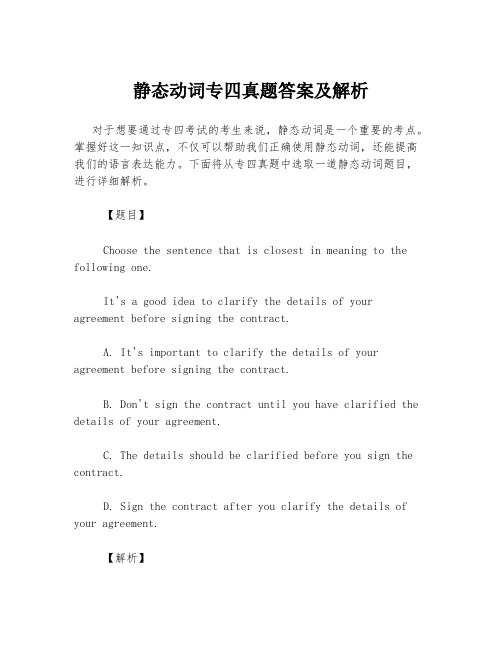
静态动词专四真题答案及解析对于想要通过专四考试的考生来说,静态动词是一个重要的考点。
掌握好这一知识点,不仅可以帮助我们正确使用静态动词,还能提高我们的语言表达能力。
下面将从专四真题中选取一道静态动词题目,进行详细解析。
【题目】Choose the sentence that is closest in meaning to the following one.It's a good idea to clarify the details of your agreement before signing the contract.A. It's important to clarify the details of your agreement before signing the contract.B. Don't sign the contract until you have clarified the details of your agreement.C. The details should be clarified before you sign the contract.D. Sign the contract after you clarify the details of your agreement.【解析】这道题目考察的是选择最接近意思的句子。
我们需要理解原句的含义,并且将其转化为其他符合原意的表达方式。
原句的意思是在签署合同之前澄清协议的细节是个好主意。
从选项中我们可以看出,选项A、B、C、D都包含了澄清细节和签署合同的概念。
我们需要仔细比较这些选项,找出最符合原句意思的答案。
选项A中使用了"important"来表达"good idea"的意思,选项B使用了"until"来表达"before"的意思,选项C使用了"should"来表达"it's a good idea"的意思,选项D使用了"after"来表达"before"的意思。
静态测试实验报告

静态测试实验报告静态测试实验报告引言静态测试是软件测试中的一种重要方法,通过对软件代码、文档、设计等进行检查和分析,发现潜在的问题和错误,以提高软件质量。
本实验旨在通过进行静态测试,评估一个简单的软件程序的质量,并提供相关的实验报告。
实验背景本次实验选择了一个简单的计算器程序作为测试对象。
该程序能够实现基本的四则运算功能,并具备一定的界面交互。
通过对该程序进行静态测试,我们可以了解在代码实现和设计方面是否存在问题,并进一步优化和改进。
实验过程1. 静态代码分析首先,我们对计算器程序的源代码进行静态代码分析。
通过阅读代码,我们可以发现以下几个问题:a. 变量命名不规范:部分变量命名不符合命名规范,不易于理解和维护。
b. 冗余代码:部分代码存在冗余,影响代码的可读性和性能。
c. 逻辑错误:部分代码中存在逻辑错误,导致程序运行结果不符合预期。
2. 文档评估除了对源代码进行分析,我们还评估了计算器程序的相关文档,包括用户手册和设计文档。
通过评估,我们发现以下问题:a. 用户手册不完善:用户手册中缺少对程序使用方法的详细说明,对用户来说不够友好。
b. 设计文档不清晰:设计文档中对程序的架构和模块划分描述不够清晰,不利于后续的维护和扩展。
实验结果基于以上的静态测试分析,我们得出了以下实验结果:1. 代码优化:针对代码中的变量命名不规范和冗余代码问题,我们进行了优化和改进。
通过重新命名变量和删除冗余代码,提高了代码的可读性和性能。
2. 逻辑修复:通过对逻辑错误的分析和修复,我们确保了程序运行结果的正确性。
3. 文档改进:根据对用户手册和设计文档的评估,我们对文档进行了改进和完善。
添加了详细的使用说明和清晰的架构描述,提升了用户体验和程序的可维护性。
讨论与总结静态测试是软件测试中的重要环节,通过对软件代码和文档的分析,可以发现潜在的问题和错误,提高软件的质量和可维护性。
本次实验中,我们对一个简单的计算器程序进行了静态测试,并根据测试结果进行了优化和改进。
体验商务英语综合教程4考试参考

Vocabulary
Common prefixes that form opposite meanings. • dis disadvantage; dislike • il illogical; illegal • im impossible; impolite • in incomplete; incapable • ir irregular; irresponsible • mis mislead; misunderstand • non nonsmoker; nonstop • un unfair; uncomfortable
articulate [ɑ:‘tikjuleit]口才好的 coherent [kəu’hiərənt] 条理清楚的 eloquent [‘eləkwənt] 有说服力的;雄辩的 fluent focussed hesitant inhibited [in’hibitid]拘谨的;羞怯的 lucid [‘lju:sid]明了易懂的 persuasive rambling 漫无边际;杂乱无章 responsive sensitive succinct [sək'siŋkt, sə's-] 简洁的;简明的 tongue-tied
• For each of the following sentences, choose the best reporting verb. 1) I’ll send you the revised figures by the end of the week. a) apologise b) warn c) promise ✔ 2) Sorry about the delay. a) b) remind c) suggest ✔apologise 3) I could come in early tomorrow to speed things up a bit, if you like. a) admit b) promise ✔offer c) 4) Our after-sales service isn’t always up to scratch (达到 标准,情况良好), let’s face it. a) suggest b) ✔ acknowledge c) advise 5) Don’t forget to bring the sales figures. a) remind b) deny c) insist
